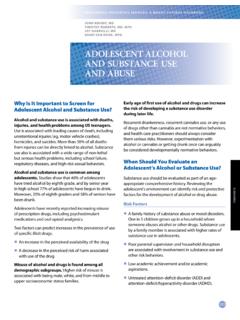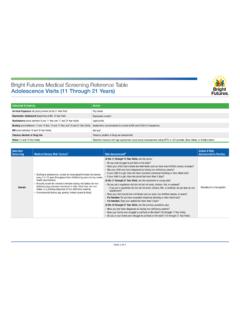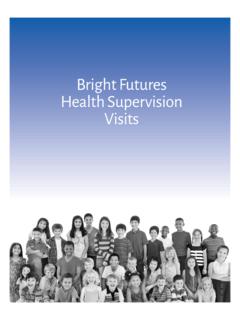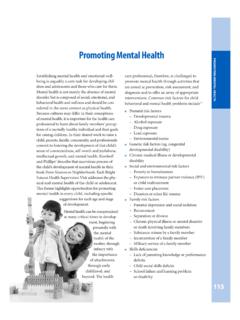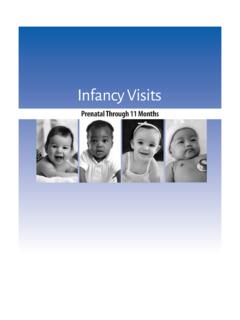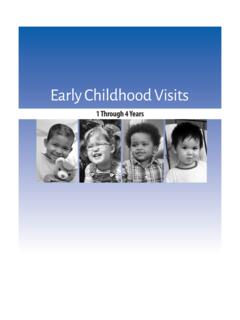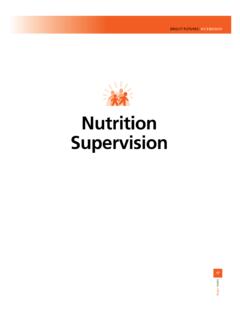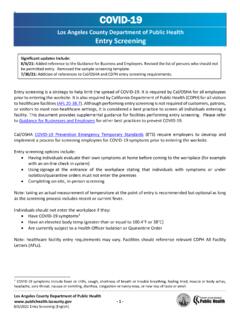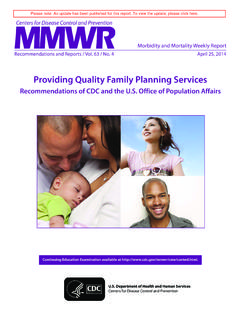Transcription of Evidence and Rationale - Bright Futures
1 Evidence and Rationale Health supervision is a complex and comprehen- to measure. In addition, individual preventive ser- sive package of services that takes place over each vices are not provided in isolation but are additive. child's lifetime. It includes recommended preven- For example, recommendations about how to have tive interventions, such as counseling or screening, a stimulating but safe environment can be based and addresses the particular needs of each child on a developmental assessment and at the same in the context of family and community. Pediatric time incorporate anticipatory guidance promoting Evidence AND Rationale . health care professionals have a unique opportu- early literacy. nity to assess the health and developmental trajec- Evidence regarding the overall benefit and fea- tory of children over time because of the frequent sibility of providing preventive services in the visits for both well-child and sick care.
2 Monitoring primary care setting continues to be central to the a child's health over time (known as surveillance) recommendations for child health supervision is an important and complementary process of in the Bright Futures Guidelines. We continue to defined periodic assessment using standardized emphasize that lack of Evidence does not mean screening tools. a lack of effectiveness. However, we also recog- The Bright Futures /AAP Recommendations for nize the importance of demonstrating the value Preventive Pediatric Health Care (Periodicity of the services that are central to pediatric care Schedule) are the standard for child preventive and for ensuring that the potential benefit of each services. The Bright Futures Guidelines, 4th Edition, recommended preventive service is balanced provide, Evidence -informed guidance for imple- against potential harm (eg, labeling, overdiagno- menting the recommendations included in the sis, opportunity cost).
3 Filling the Evidence gaps is Periodicity Schedule. The Bright Futures Guidelines highly desirable, and additional research is strongly also describe other preventive care services that are However, it is not necessarily in the likely to be beneficial but that are not supported by best interests of children's health for many of the the same degree of Evidence . In these instances, the specific interventions to stop until the Evidence Guidelines provide a Rationale for the recommended base is adequate. We believe that it is central to the preventive service and guidance to help pediatric practice of pediatric preventive care for health care health care professionals implement the service. professionals to understand the current state of the We encourage pediatric health care professionals Evidence , and we hope that they will participate to also adopt these recommendations, for they in the important work necessary to improve the were developed by expert panels with extensive Evidence base.
4 Feedback from families and the general public. The Periodicity Schedule is reserved for preven- Understanding the value of any specific preven- tive services with the highest degree of sup- tive care service for children and their families is porting Evidence . Included are the Grade A and challenging because the intended outcomes may Grade B recommendations made by the US. not develop for many years and may be difficult Preventive Services Task Force (USPSTF), the 275. BFG 4TH 275 1/20/17 2:47 PM. Bright Futures Guidelines for Health Supervision of Infants, Children, and Adolescents community-based recommendations endorsed by Ambulatory Medicine. Deciding which preven- the Centers for Disease Control and Prevention tive services should be included in the Periodicity (CDC) Community Guide, and other preventive Schedule is a complex task because of the incom- care services endorsed by the American Academy plete Evidence base regarding benefits and harms of Pediatrics (AAP) Executive Committee and of preventive care services.
5 The committees are Board of Directors. All of these services are based fully committed to using a clearly defined and on a high degree of certainty of net benefit to chil- fully transparent process that weighs benefits, dren and their families. The Periodicity Schedule risk, and uncertainties of preventive services when is continually reviewed and updated between edi- making recommendations for updates to the tions of the Bright Futures Guidelines in a process Periodicity Schedule. directed by the Bright Futures Steering Committee and the AAP Committee on Practice and Evidence AND Rationale . 276. BFG 4TH 276 1/20/17 2:47 PM. Bright Futures Guidelines for Health Supervision of Infants, Children, and Adolescents Updates to Recommended Preventive Services Since the Bright Futures Guidelines, 3rd Edition The following preventive services are new to the Bright Futures Guidelines, 4th Edition.
6 Other preventive services contained in the Periodicity Schedule have been modified to be in step with new recommenda- tions. A more detailed summary of changes can be found on the Periodicity Schedule at periodicityschedule. Universal prepubertal cholesterol screening (in addition to the existing universal cholesterol screening in late adolescence). Universal depression screening for adolescents Universal human immunodeficiency virus (HIV) screening in middle/late adolescence Universal maternal depression screening Evidence AND Rationale . Universal newborn critical congenital heart disease screening Universal newborn bilirubin screening Oral health (universal fluoride varnish for ages 6 months through 5 years, in addition to universal fluoride supplementation for ages 6 months to 16 years). Universal adolescent hearing screening This following preventive service has been deleted from the Periodicity Schedule: Annual pelvic examinations for cervical dysplasia for sexually active adolescent and young adult females before age 21 years Evidence Summaries and Rationale Tables Bright Futures and its partners strive to ensure that, to the greatest extent possible, children receive health promotion and preventive services that are comprehensive, Evidence based, and Evidence informed and that reflect the knowledge and experience of the health care professionals from many disciplines who work together to ensure best outcomes in childhood and throughout the life course.
7 The remainder of this chapter presents the components of the Periodicity Schedule included in the fourth edition of the Bright Futures Guidelines. Each component begins with text that summarizes the supporting Evidence . This summary is followed by tables that provide Evidence citations, the Rationale for the screen- ing tasks, techniques, and risk assessment questions used in the Guidelines. The components are presented alphabetically by topic, unlike the Periodicity Schedule, which follows a different order. 277. BFG 4TH 277 1/20/17 2:47 PM. Bright Futures Guidelines for Health Supervision of Infants, Children, and Adolescents Anemia The USPSTF has concluded that current Evidence is insufficient to recommend for or against screening for iron deficiency anemia in infants and children between 6 and 24 months of age (I Statement).2. Screening for anemia has limited accuracy for iron deficiency.
8 Treatment of iron deficiency anemia shows improvement in iron deficiency but not necessarily in developmental outcomes. Evidence suggests some harm caused by increased incidence of iron poisoning when iron-containing medications are kept in the home. No high-quality studies were found regarding screening adolescents for anemia. Because iron deficiency is associated with many and sometimes subtle detrimental effects, the AAP rec- ommends iron supplementation or fortification in infants. They also recommend that all infants at age 12 months be screened for anemia by determining hemoglobin concentration. Anemia: Universal Evidence AND Rationale . Bright Futures Visits 12 Month Citation American Academy of Pediatrics Committee on Nutrition. Iron. In: Kleinman RE, Greer FR, eds. Pediatric Nutrition: Policy of the American Academy of Pediatrics. 7th ed. Elk Grove Village, IL: American Academy of Pediatrics; 2014:449-466 (p 462).
9 278. BFG 4TH 278 1/20/17 2:47 PM. Bright Futures Guidelines for Health Supervision of Infants, Children, and Adolescents Anemia: Selective Bright Futures Visits 4, 15, 18 Month; 2, 2 Year, Annually Beginning With 3 Year Risk assessment 4 Month Visit Prematurity Low birth weight Use of low-iron formula or infants not receiving iron-fortified formula Early introduction of cow's milk 15, 18 Month; 2, 2 , 3, 4, 5 Year Visits At risk of iron deficiency because of special health needs Low-iron diet (eg, nonmeat diet). Environmental factors (eg, poverty, limited access to food). Evidence AND Rationale . Citation American Academy of Pediatrics Committee on Nutrition. Iron. In: Kleinman RE, Greer FR, eds. Pediatric Nutrition: Policy of the American Academy of Pediatrics. 7th ed. Elk Grove Village, IL: American Academy of Pediatrics; 2014:449-466 (p 457). Risk assessment 6 through 10 Year Visits Children who consume a strict vegetarian diet and are not receiving an iron supplement Environmental factors (eg, poverty, limited access to food).
10 Citation American Academy of Pediatrics Committee on Nutrition. Iron. In: Kleinman RE, Greer FR, eds. Pediatric Nutrition: Policy of the American Academy of Pediatrics. 7th ed. Elk Grove Village, IL: American Academy of Pediatrics; 2014:449-466 (p 460). Risk assessment Adolescents (11 through 21 Year Visits). Starting in adolescence, screen all nonpregnant females for anemia every 5 to 10 years throughout their childbearing years during routine health examinations. Annually screen for anemia in females having risk factors for iron deficiency (eg, extensive menstrual or other blood loss, low iron intake, or a previous diagnosis of iron deficiency anemia). Environmental factors (eg, poverty, limited access to food). Citation American Academy of Pediatrics Committee on Nutrition. Iron. In: Kleinman RE, Greer FR, eds. Pediatric Nutrition: Policy of the American Academy of Pediatrics.



